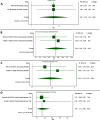Environmental pollutants as risk factors for autism spectrum disorders: a systematic review and meta-analysis of cohort studies
- PMID: 39223561
- PMCID: PMC11370099
- DOI: 10.1186/s12889-024-19742-w
Environmental pollutants as risk factors for autism spectrum disorders: a systematic review and meta-analysis of cohort studies
Abstract
Background: Autism Spectrum Disorder (ASD) is a lifelong neurodevelopmental condition affecting communication, social interaction, and behavior. Evidence suggests that environmental pollutants are associated with ASD incidence. This review aimed to analyze the effect of environmental pollutants on ASD.
Methods: Systematic review and meta-analysis of cohort studies evaluated the association between exposure to environmental pollutants and ASD. We searched COCHRANE CENTRAL, MEDLINE, CINAHL, LILACS, EMBASE, PsycINFO, Web of Science, SciELO, and gray literature from inception to January 2023. The model used for meta-analysis was inverse variance heterogeneity (IVhet). The effect measures were the beta coefficient (β) and the relative risk (RR) with their 95% confidence intervals (95% CI). Sensitivity analyses were carried out using an instrument to screen or diagnose autism.
Results: A total of 5,780 studies were identified; 27 were included in the systematic review, and 22 were included in the meta-analysis. These studies included 1,289,183 participants and 129 environmental pollutants. Individual meta-analyses found a significant association between nitrogen dioxide RR = 1.20 (95% CI: 1.03 to 1.38; I2: 91%), copper RR = 1.08 (95% CI: 1.03 to 1.13; I2: 0%), mono-3-carboxy propyl phthalate β = 0.45 (95% CI: 0.20 to 0.70; I2: 0%), monobutyl phthalate β = 0.43 (95% CI: 0.13 to 0.73; I2: 0%) and polychlorinated biphenyl (PCB) 138 RR = 1.84 (95% CI: 1.14 to 2.96; I2:0%) with ASD. Subgroup meta-analyses found a significant association with carbon monoxide RR = 1.57 (95% CI: 1.25 to 1.97; I2: 0%), nitrogen oxides RR = 1.09 (95% CI: 1.04 to 1.15; I2: 34%) and metals RR = 1.13 (95% CI: 1.01 to 1.27; I2:24%).
Conclusion: This study found positive associations nitrogen dioxide, copper, mono-3-carboxypropyl phthalate, monobutyl phthalate, and PCB 138, and the development of ASD, likewise, with subgroups of pollutants carbon monoxide, nitrogen oxides, and metals. Therefore, it is important to identify these risk factors in children and adolescents to contribute to ASD and identify prevention strategies effectively.
Keywords: Autism; Cohort studies; Environmental pollutants; Systematic review.
© 2024. The Author(s).
Conflict of interest statement
The authors declare no competing interests.
Figures





References
-
- Maenner MJ, Warren Z, Williams AR, Amoakohene E, Bakian AV, Bilder DA, et al. Prevalence and Characteristics of Autism Spectrum Disorder Among Children Aged 8 Years — Autism and Developmental Disabilities Monitoring Network, 11 Sites, United States, 2020. MMWR Surveill Summ. 2023;72(2):1–14. 10.15585/mmwr.ss7202a1 - DOI - PMC - PubMed
-
- Saghazadeh A, Rezaei N. Systematic review and meta-analysis links autism and toxic metals and highlights the impact of country development status: Higher blood and erythrocyte levels for mercury and lead, and higher hair antimony, cadmium, lead, and mercury. Prog Neuro-Psychopharmacology Biol Psychiatry. 2017;79:340–68. 10.1016/j.pnpbp.2017.07.011 - DOI - PubMed
Publication types
MeSH terms
Substances
LinkOut - more resources
Full Text Sources
Medical

